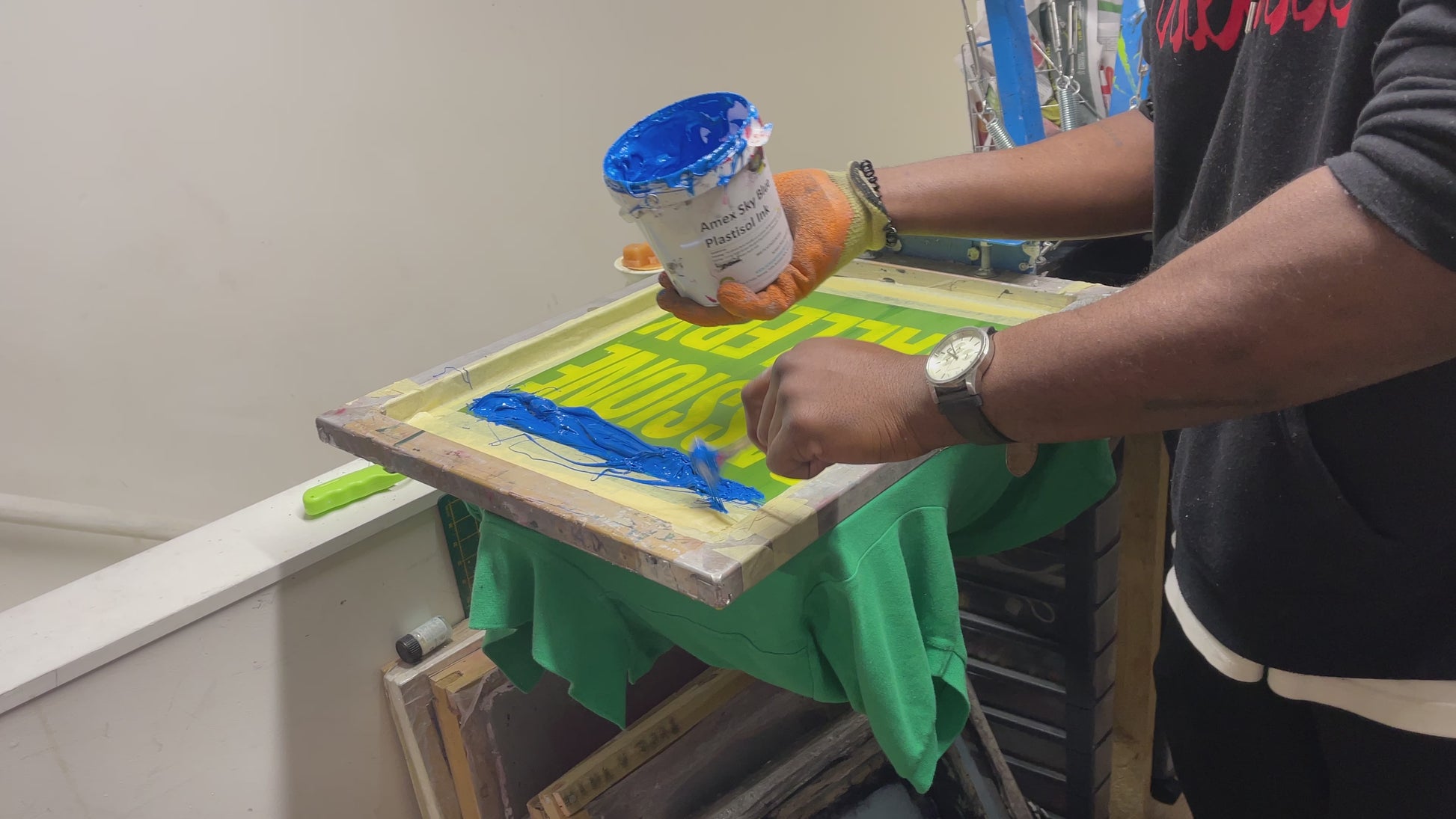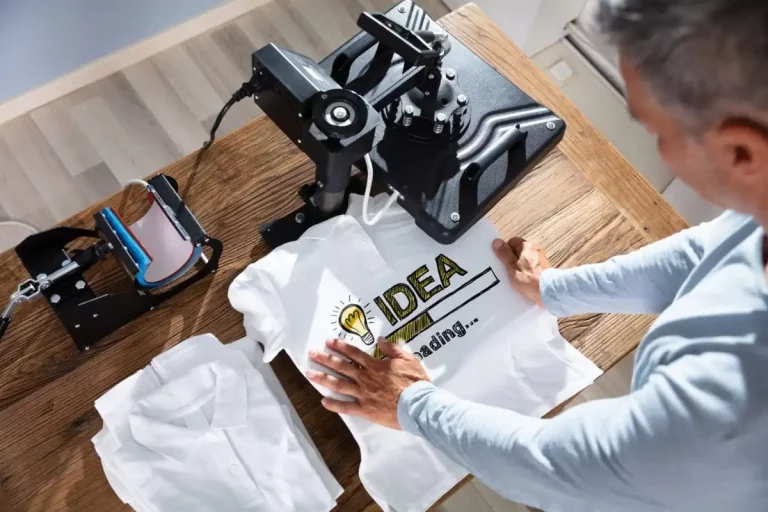Budget-Friendly T-Shirt Printing for Startups
Screen Printing Uncovered: Every Little Thing You Required to Find Out About Tee Shirt and Garment Printing Methods
Screen printing is a remarkable technique that incorporates art with technique, supplying countless opportunities for creativity. Prepared to discover the crucial components that make screen printing an art form?
The Basics of Screen Printing: Just How It Functions
When you plunge into display printing, you'll discover it's both an art and a scientific research. At its core, display printing includes developing a pattern, or display, that allows ink to go through only in certain areas (screen printing kit). You begin by choosing your design and preparing your display with a light-sensitive solution. When you expose this emulsion to light, it sets, leaving your layout as a negative room.
Next, you'll blend your inks and prepare your printing surface. Setting the screen over the textile, after that use a squeegee to press ink via the display onto the garment. This procedure calls for precision, as you desire clear, vivid prints. After printing, you'll cure the ink with warm, guaranteeing it abides by the fabric and lasts with cleans. Each action is crucial, and understanding them will raise your display printing abilities, changing simple garments into one-of-a-kind, meaningful pieces.
Sorts Of Screen Printing Methods
As soon as you comprehend the fundamentals of screen printing, it's time to check out the different methods that can elevate your layouts. One popular approach is conventional display printing, where ink is pushed through a stenciled screen.
If you're aiming for great information, consider discharge printing. This strategy eliminates dye from the material, leaving a soft, vintage look. One more option is plastisol printing, known for its longevity and vibrant colors, making it a preferred for lots of brand names. Experiment with halftone printing to create slope impacts and elaborate styles. Each technique has its one-of-a-kind appeal, so don't wait to try them bent on find what matches your style best!
Essential Equipment for Screen Printing
To accomplish spectacular cause screen printing, having the right tools is essential. You'll require a tough screen printing framework, which holds the mesh that transfers your layout onto the garment. Next, invest in high-quality mops; these are crucial for using ink evenly throughout the screen. You'll likewise call for a good exposure system to develop your displays, as well as a washout cubicle for cleansing them after usage. A trustworthy warmth resource, like a conveyor dryer or warmth press, is crucial for healing your prints to ensure longevity. Don't fail to remember a correct work area, geared up with tables and storage for your supplies. Protective gear, such as masks and handwear covers, will keep you secure from chemicals and inks. With the right tools, you'll be well on your method to generating professional-quality prints.
Picking the Right Inks and Materials
When picking inks and materials for display printing, you need to take into consideration the sort of ink that functions finest for your project. Think of material compatibility to assure your designs look terrific and last lengthy. Also, check out green ink alternatives to make your printing procedure extra lasting.
Types of Screen Inks
Picking the ideal screen ink is essential for accomplishing lively, sturdy prints that meet your job's needs. There are several kinds of screen inks to analyze. Specialty inks, such as metal or glow-in-the-dark, can add unique effects to your designs.

Material Compatibility Considerations
Comprehending fabric compatibility is essential for achieving top quality screen prints, especially considering that various materials react distinctly to different inks. When choosing inks, consider the material type-- cotton, polyester, or blends. For cotton, water-based inks work well, supplying softness and breathability. Polyester, on the various other hand, typically needs plastisol inks for much better adhesion and vivid shades. If you're publishing on blends, you may need to utilize a mix of both kinds. Always evaluate your inks on example textile to assure they adhere correctly and keep shade stability. Additionally, keep in mind that textile weight and texture can affect the last result, so choosing the appropriate ink and material combo is important for your project's success.
Eco-Friendly Ink Options
Eco-friendly inks are ending up being a preferred option for display printers who want to lessen their environmental impact while keeping high quality. When picking inks, take into consideration water-based inks, which are much less harmful and easier to cleanse up contrasted to standard solvents.
In addition, look for inks made from eco-friendly sources, such as soy or vegetable-based options. By picking the right inks and products, you'll not only develop spectacular styles yet also add to an extra lasting printing process. Make the button, and your prints will mirror your dedication to the atmosphere!
Preparing Your Design for Display Printing

File Format Demands
To ensure your design looks lively and sharp on fabric, you'll require to pay close interest to file style demands for screen printing. Make certain your layout has a clear history to prevent unwanted white edges on your prints. Keep color settings in mind; CMYK is typical for screen printing, so convert your RGB designs appropriately.
Color Separation Strategies
Color separation is a necessary step in preparing your layout for display printing, and understanding it can significantly enhance your print high quality. You'll need to damage your layout right into private shades, as each color requires a different screen during printing. This accuracy not just guarantees accurate shade depiction but likewise improves the printing process.
Resolution and Size
Achieving the very best cause screen printing starts with assuring your layout has the best resolution and size. Preferably, your art work ought to be at least 300 DPI (dots per inch) for sharp, clear prints. Your last product could look unprofessional and pixelated. if you make use of lower resolution.
When it comes to size, take into consideration the measurements of your print area. Design your art work to match the last print dimension, preferably developing it in the actual dimensions you'll be printing. By doing this, you'll prevent any kind of unexpected scaling concerns.
Constantly examine your layout in both vector and raster formats. Vector graphics can be scaled without shedding high quality, making them ideal for display printing. Preparing appropriately will ensure your style looks amazing on every garment!
Step-by-Step Display Printing Refine
Screen printing is a dynamic process that allows you to develop vibrant designs on various surface areas. To get begun, you'll require a screen, solution, and your picked ink.
After rinsing the unexposed solution, your screen prepares. Establish it up on your printing surface and align your garment below it. Pour ink onto the display and use a squeegee to push the ink with the pattern onto the textile. Lift the screen thoroughly and allow the print completely dry. Treat the ink utilizing warmth to ensure sturdiness. That's it! You've successfully display published your layout.
Tips for Successful Screen Printing Projects
While you're diving into your screen printing tasks, keep in mind that preparation is key to success. Start by collecting all your materials-- inks, screens, mops, and garments. A clean office assists avoid undesirable mistakes, so clean before you begin.
Next, confirm your artwork is high-resolution and appropriately sized for your garment. Test your display for appropriate direct exposure and clean it extensively to avoid smudges. When blending your inks, comply with the maker's guidelines to achieve the best consistency.
Throughout printing, use also pressure with your squeegee for consistent outcomes. Do not rush; take your time to confirm each print fulfills your standards. After printing, let your garments dry entirely before handling or packaging them.
Finally, constantly maintain an example of your job for future reference. In this manner, you can examine your development and enhance your strategies gradually. Happy printing!

Regularly Asked Questions
How much time Does It Take to Establish up a Display Printing Task?
Establishing a display printing job commonly takes about 30 mins to an hour. You'll prepare the screens, mix inks, and change journalism. The time differs based on intricacy and experience, so stay organized!
Can I Print on Various Textile Types Using the Exact Same Strategy?
Yes, you can print on various material types using the exact same strategy, yet you'll require to change your settings and inks. Some textiles absorb ink differently, so trying garment printing out warranties the most effective outcomes for each material.
What Are Usual Errors to Prevent in Screen Printing?
When screen printing, stay clear of typical mistakes like using the incorrect ink, ignoring proper direct exposure times, or avoiding pre-press checks. Constantly check your arrangement and keep clean displays to assure high quality outcomes each time.
How Can I Effectively Clean and Keep My Display Printing Equipment?
To properly tidy and keep your screen printing tools, you should on a regular basis clean screens with appropriate solvents, inspect squeegees for wear, and ensure all devices are kept completely dry and dust-free. Consistency boosts and stops costly fixings efficiency.
Is Display Printing Environmentally Pleasant Contrasted to Other Techniques?
Screen printing can be much more eco-friendly than other approaches, particularly if you utilize eco-conscious materials and water-based inks. By picking sustainable supplies and practices, you decrease waste and reduce your influence on the planet.
Display Printing Uncovered: Everything You Need to Know About Tee and Garment Printing Methods
At its core, display printing includes developing a stencil, or display, that enables ink to pass with just in certain areas. Setting the display over the textile, then make use of a squeegee to push ink via the display onto the garment. One preferred approach is typical screen printing, where ink is pressed with a stenciled display.When picking inks and materials for display printing, you require to take right into account the kind of ink that functions ideal for your task.